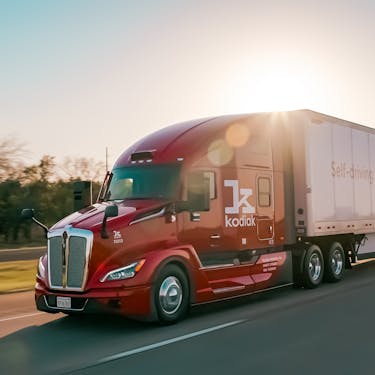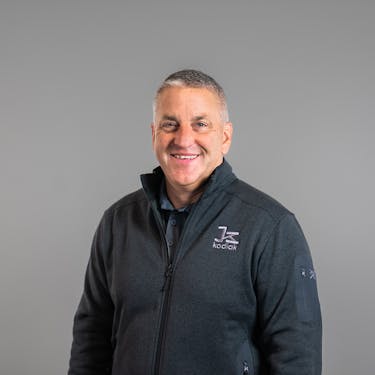– Brett FabbriHuman error is the most dangerous part of driving. That’s why I’m so passionate about what we’re doing at Kodiak.
AV Trucks Will Improve Highway Safety
|

Over the course of a thirty year career in law enforcement, I saw firsthand the impact that highway accidents had on families and communities.
The number of Americans that died in crashes involving large trucks or buses grew from 3,200 in 2010 to 4,500 in 2019. As of early 2022, the U.S. Department of Transportation has released preliminary data suggesting that there’s been a sharp increase in all highway fatalities.
Autonomous trucking offers us a chance to reduce roadway fatalities while also bolstering our supply chain. Over the last two years, Americans have become increasingly cognizant of the fragility of the supply chain systems that sustain our way of life. We shouldn’t be surprised that during a general labor shortage in all economic sectors, it is especially hard to find people who want to drive a truck. While there are certainly people who love the job and the open road, long-haul trucking is a difficult, dangerous profession that keeps people away from their families for weeks or even months at a time. The number of trucking professionals is shrinking as many experienced drivers are nearing retirement and fewer young people are interested in entering such a mentally and physically demanding job.
Despite the recent headlines, COVID did not cause the supply chain crisis: it merely exacerbated existing trends. The American Trucking Association currently estimates the shortage at 80,000 drivers and growing. This number is projected to double to 160,000 drivers by 2030.
Before I retired from the California Highway Patrol, I had the privilege of serving as Assistant Chief in the Enforcement and Planning Division, responsible for California’s Commercial Vehicle Program. In that role, I led the CHP’s efforts to understand the potential impacts of the growing autonomous trucking industry. Based on my experiences, I began to believe that autonomous trucking represents a once-in-a-generation opportunity to make our roads safer for everyone. While I understand that the idea of driverless heavy duty vehicles understandably initially frightens many, I grew to believe that autonomous trucking has the potential to transform roadway safety for future generations. When I saw an opportunity to join Kodiak as Head of Law Enforcement Policy and Highway Safety, I jumped at the opportunity to apply my experience and knowledge.
From operations to software, the autonomous trucking industry is already setting an incredibly high safety standard, and operating some of trucking’s safest, best-maintained fleets. Today, autonomous trucking companies are operating their technology with highly-experienced, highly-trained “safety drivers” behind the wheel and carefully monitoring the vehicle at all times. These drivers are trained to operate their trucks safely, avoid dangerous situations, and ensure safe operations until the day that their digital drivers are safer than human ones.
That being said, autonomous trucks already have many capabilities that no human has, like getting tired at the end of a grueling 14 hour day. Unlike a human, which can only pay attention to one spot on the road at a time, autonomous trucks can simultaneously monitor nearly 360 degrees around the vehicle, using multiple sensor types. This helps autonomous trucks react to other vehicles, people, and hazards on the road much more quickly than a person ever could be able to. When over 90% of collisions are human error, the opportunity to reduce human error in collisions is a monumental shift in improving safety on our roadways.
Autonomous trucks are also programmed to be courteous, safe drivers. Autonomous trucks never get distracted by the environment, their cell phones, or lose focus on a long trip. They never speed, even if they’re running late on a delivery, or weave in and out of traffic affecting other motorists. They’re also constantly learning, across the fleet – what one truck learns, they all do.
But the benefits of this technology go well beyond safety. Autonomous trucks are easy on the gas and brakes, and are already showing approximately 10% fuel savings across the fleet. They don’t care if it’s 5 AM or 5 PM, and will be able to move freight at might instead of typically crowded daytime freeways, reducing traffic congestion. Autonomous trucks will drive predictably and safely, mostly staying in the right lane. Perhaps most importantly other than safety, autonomous trucks will be a major boon to the economy, helping to resolve the supply chain issues that have touched every American over the past 18 months and reducing one of the main bottlenecks to job creation throughout the economy. In fact, a recent United States Department of Transportation-funded study predicted that autonomous trucks will create over 25,000 new jobs a year in the US, while raising wages for workers by over $200 a year.
Of course, there is still work to do on both the engineering and regulatory side to make this technology a reality. Kodiak is working to build its safety case – its engineering argument that its trucks are safer than the average human driver. Just as importantly, we have work to do in partnership with law enforcement, including my former colleagues at the California Highway Patrol, to adapt existing regulations and processes to the needs of autonomous trucks.
One of law enforcement’s most critical regulatory roles is enforcing the regulations designed to ensure that America’s trucking fleet is roadworthy, most importantly through commercial vehicle inspections. At Kodiak, I’ve worked closely with my former law enforcement colleagues at the Commercial Vehicle Safety Alliance (CVSA) to develop an Enhanced Inspection Program designed to adapt existing trucking regulations and standards to a self-driving future. These discussions have yielded considerable progress, and in the last few months we have developed a regulatory framework that will ensure that autonomous trucks are among the safest, best maintained commercial vehicles on the road.
I understand why so many have questions about this technology – it represents a huge shift in how we think about road safety. But in the very near future, I firmly believe drivers will look up and see empty truck cabs on the highways, and feel a sense of safety, trusting that “the driver” behind the wheel is the safest on the road.


